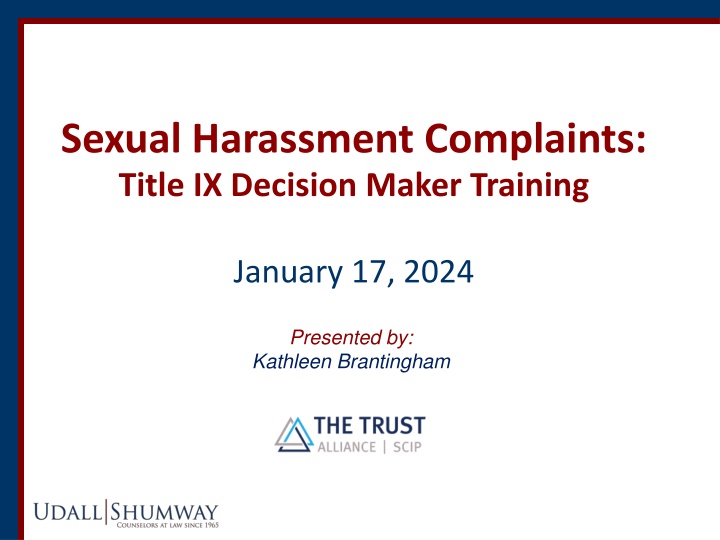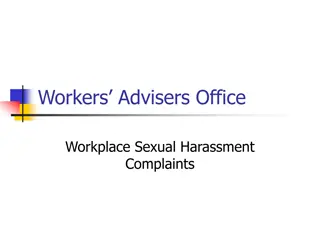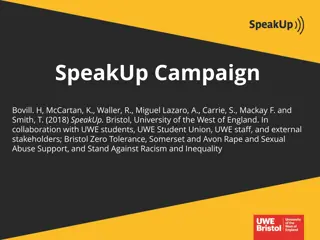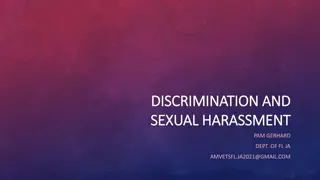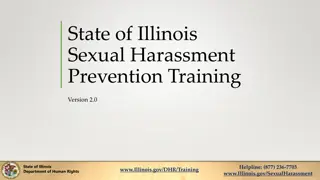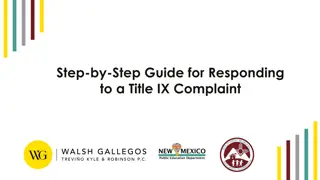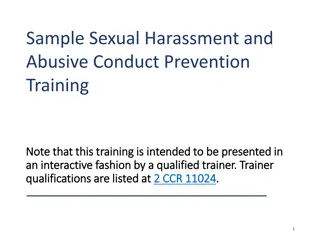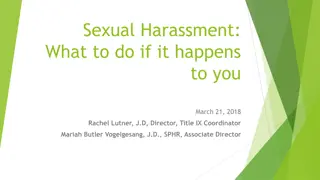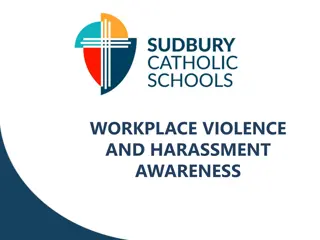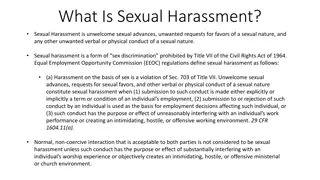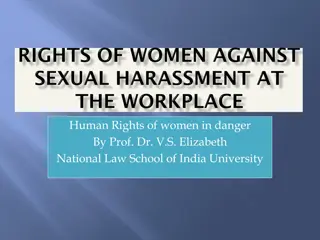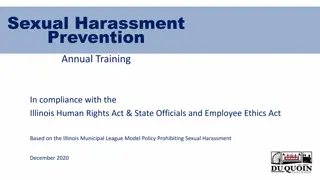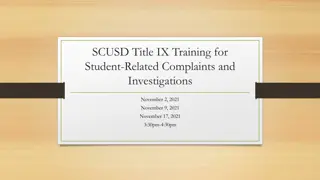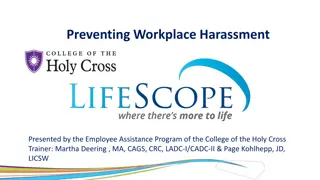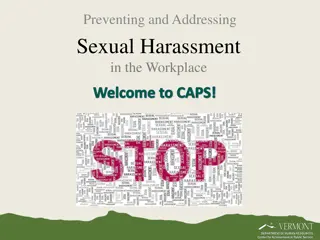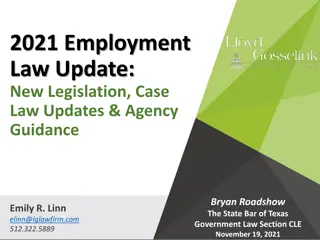Understanding Title IX: Sexual Harassment Complaints
Title IX prohibits sex discrimination in education programs and activities, providing protections against discriminatory practices. Learn about its scope, what it is, and what it is not to ensure a safe educational environment.
Download Presentation

Please find below an Image/Link to download the presentation.
The content on the website is provided AS IS for your information and personal use only. It may not be sold, licensed, or shared on other websites without obtaining consent from the author.If you encounter any issues during the download, it is possible that the publisher has removed the file from their server.
You are allowed to download the files provided on this website for personal or commercial use, subject to the condition that they are used lawfully. All files are the property of their respective owners.
The content on the website is provided AS IS for your information and personal use only. It may not be sold, licensed, or shared on other websites without obtaining consent from the author.
E N D
Presentation Transcript
Sexual Harassment Complaints: Title IX Decision Maker Training January 17, 2024 Presented by: Kathleen Brantingham
Scope of Title IX for Schools Prohibits discrimination and harassment based on sex in education programs and activities at schools that receive federal funding. No person in the United States shall, on the basis of sex, be excluded from participation in, be denied the benefits of, or be subjected to discrimination under any education program or activity receiving Federal financial assistance.
Scope of Title IX for Schools If any part of a K-12 school or college receives federal funding for any purpose, then all operations of the school or college are covered by Title IX Protects students, employees, applicants for employment, students who are applying to the school and any other person who may participate in the School s activities and/or programs Includes sexual harassment prohibitions for employees and students as well
Title IX: What It Is & What It Isnt Title IX is not an anti-sexual harassment statute; Title IX prohibits sex discrimination in education programs or activities. The Supreme Court has held that sexual harassment may constitute sex discrimination under Title IX, but only when the sexual harassment is so severe, pervasive, and objectively offensive that it effectively denies a person s equal access to education. Title IX does not represent a zerotolerance policy banning sexual harassment as such, but does exist to provide effective protections to individuals against discriminatory practices, within the parameters set forth under the Title IX statute (20 U.S.C. 1681 et seq.) and Supreme Court case law.
Title IX: What It Is & What It Isnt For the same reasons that Title IX does not stand as a zero- tolerance ban on all sexual harassment, Title IX does not stand as a Federal civil rights law to prevent all conduct that makes me feel uncomfortable. The Supreme Court noted in Davis v. Monroe County Board of Ed. that school children regularly engage in insults, banter, teasing, shoving, pushing, and gender- specific conduct that is upsetting to the students subjected to it yet a school is liable under Title IX for responding to such behavior only when the conduct is so severe, pervasive, and objectively offensive that it denies its victims the equal access to education that Title IX is designed to protect.
In order to investigate and make decisions about sexual harassment, we must UNDERSTAND REGULATIONS DEFINITION OF SEXUAL HARASSMENT
Sexual Harassment The regulations use a definition of sexual harassment that is designed to protect 1st Amendment rights of students and teachers by: Distinction between physical conduct and speech Speech is largely protected unless it rises to high standard-no prior restraint on speech Physical conduct is per se actionable
Definition of Sexual Harassment Conduct on the basis of sex that is one or more of the following: 1. A school employee conditions the provision of an aid, benefit, or service of the school on an individual s participation in unwelcome sexual conduct; 2. Unwelcome conduct that a reasonable person would find to be so severe, pervasive, and objectively offensive that it effectively denies a person equal access to the school s education program or activity; 3. Sexual assault, dating violence, domestic violence, or stalking.
Definition of Sexual Harassment: Element 1 Element 1 is quid pro quo harassment Does not require a severe, pervasive, and objectively offensive analysis By its very terms, it will deny access to the program Examples: a teacher requires sexual favors for a better grade; a staff member demands sexual favors or will post compromising pictures
Definition of Sexual Harassment: Element 2 Harassment based on speech This prong requires the unwelcome sexual conduct to be: Severe AND Pervasive AND Objectively offensive Such that the victim is denied equal access to the school s programs and activities. Narrowly tailored to protect 1st Amendment rights
Definition of Sexual Harassment: Element 3 Offenses based on violence (sexual assault, dating violence, domestic violence, stalking): Does not require severe and pervasive analysis When it occurs, equal access is denied Like Element 1, it is per se actionable
Element 3 Definitions Sexual assault: an offense classified as a forcible or nonforcible sex offense under the uniform crime reporting system of the Federal Bureau of Investigation Stalking: means engaging in a course of conduct directed at a specific person that would cause a reasonable person to: 1) fear for his or her safety or the safety of others; or 2) suffer substantial emotional distress
Dating Violence Violence committee by a person who is or has been in a social relationship of a romantic or intimate nature with the victim and where the existence of such a relationship shall be determined consideration of the following factors: based on a 1) the length of the relationship; 2) the type of relationship; 3) the frequency of interaction between the persons involved in the relationship
Domestic Violence Violence committed by a current or former spouse or intimate partner of the victim, a person whom the victim shares a child in common, by a person who is cohabitating with or has cohabitated with the victim as a spouse or intimate partner, by a person similarly situated to a spouse of the victim under the domestic or family violence laws of Arizona, or by any other person against an adult or youth victim who is protected from that person s acts under the domestic or family violence laws of the jurisdiction
TITLE IX REMINDERS FOR DISTRICTS
School Liability A school will violate Title IX where it has actual knowledge of an allegation of sexual harassment experienced by an individual in the educational program and the school acts with deliberate indifferenceto that notice.
What is Deliberate Indifference? A response to notice of sexual harassment that is clearly unreasonable in light of the known circumstances
How to Avoid Deliberate Indifference Treat complainants and respondents equitably Offer supportive measures in all cases Investigate every instance of formal complaint Use procedures set out in the regulations Provide complainant remedies if respondent is found to have responsibility
Conflict of Interest Investigator/Title IX Coordinator/Decision-maker must not have a conflict of interest Against the specific complainant or respondent or Against complainants or respondents in general Coordinator Decision Maker Investigator If you have a conflict of interest, notify the Title IX Coordinator immediately
OVERVIEW OF INVESTIGATION
Formal Complaint Triggers the Investigation Formal complaint triggers responsibility to conduct an investigation that complies with the District s grievance procedure. Upon receipt of a Formal Complaint, the Title IX Coordinator will provide a written notice to parties explaining basic rights during process and will assign an investigator.
Procedural Requirements Respondent is presumed not responsible for conduct and a determination will not be made until the conclusion of the grievance process Parties may have an advisor of their choice Advisor may be an attorney, but doesn t have to be Both parties must have equal opportunity to present witnesses and evidence
Procedural Requirements Parties must be given, in writing, details about what conduct is alleged to constitute sexual harassment, including the date and location of the alleged incident(s) (TIX Coordinator will do this) If there is a prohibition against making false statements in the code of conduct, a party can be disciplined for doing so during this investigation
Procedural Requirements Parties will have the opportunity to inspect and review evidence collected during the investigation Sign a non-disclosure agreement Do not restrict either party s ability to discuss the allegations or gather and present evidence
Expanding the Investigation If, during the course of the investigation, the investigator decides to investigate additional allegations that were not included in initial notice, that should have been discussed with the Title IX Coordinator, who provided written notice of the additional allegations to the parties.
Written Notice Requirements In sufficient time to prepare a response, parties must be given written notice of the following: All of the procedural requirements above and the specifics of the allegations (Title IX Coordinator does this) Any investigative activity that will require a party s presence Invite parties to provide relevant evidence
Investigating the Complaint Interview both parties (required) Interview any witnesses identified by the parties and anyone else you identify as potentially having information Request documents from district, parties, and witnesses
Interview Phase Recommendation is to start by interviewing complainant and then the respondent Provide written notice of the date, time, location, participants, and purpose of any investigation activity that requires a party s presence and provide notice with enough time for the party to prepare to participate in the activity
Providing Parties with the Evidence Get a signed non-disclosure agreement Provide both parties an equal opportunity to inspect and review evidence gathered as part of the investigation that is directly related to the allegations raised in the formal complaint Including evidence on which you do not intent to rely on it in drafting an investigation report Send the evidence to the parties in an electronic or hard copy format and allowing the parties 10 days to submit a written response
Redacting Evidence Must redact information protected by privilege unless we have written consent May redact information in the evidence that is not directly related to the allegations May not redact confidential information that is directly related and relevant
Completing the Process Consider the written responses to evidence provided by the parties The District can decide whether parties must provide all evidence PRIOR to the investigator sending out the evidence for review OR whether it will allow parties to provide additional evidence after reviewing the existing evidence.
Investigation Report Draft a written investigation report that summarizes the relevant evidence Can include observations and even recommendations Provide the report to the parties AND their advisors, if any, at the same time for review and opportunity to provide another written response prior to the decision maker rendering a determination.
Decision-maker Responsibility DETERMINATIONS
Basic Premises: Decision Makers Objectively evaluate all available evidence, both inculpatory and exculpatory Weigh the evidence using preponderance of the evidence (or clear and convincing) burden of proof standard adopted by the District The evidence must show that it is more likely than not (or highly probable) that the respondent is responsible for the alleged conduct
Written Questions The District will not hold in-person hearings but after the investigation report is completed, and before a determination is made, the parties must have the opportunity to review the investigation report and submit written, relevant questions to the decision maker that the party wants asked of the other party or witnesses (= due process)
Written Questions Each party may submit relevant questions to decision maker If a question is excluded by the decision maker, the decision maker must explain why the question is not relevant Each party will be provided answers to its questions and then will have a limited opportunity to ask limited follow up questions
Relevance of Questions Complainant s sexual history or predisposition is NOT RELEVANT unless: Offered to establish that someone else committed the acts complained of Offered to establish consent with the specific respondent
Issuing a Determination Using a preponderance of the evidence standard to review the evidence, issue a written determination that includes the following components: 1. Allegations of the Complaint 2. Applicable Legal Standard 3. Compliance with Greivance Procedures 4. Standard of Evidence 5. Findings of Fact 6. Determination 7. Disciplinary Consequences 8. Appeal Rights
Determining Sanctions Considerations: Founded = Consequence(s) Context Age Disability (special education/504) Prior history Severity Resources district has Resources district doesn t have
Sanction Examples Change bus No classes or lunch together Restrict extra-curricular participation No Contact Agreement Behavior contract (e.g. required supervision; no discipline referrals) Counseling Threat assessment Community service Short-term suspension School reassignment (another, alternative, online) Referred for long-term suspension Referred for expulsion
Remedies If the determination is that the respondent is responsible for the conduct, then determine remedies that will restore or preserve equal access to the education program or activity Same types of things as supportive measures except that they now can be punitive toward respondent
Scenario # 1 (Teacher) You are a math teacher Is this Title IX? Your class is during third period Is this an actual knowledge report? Student A reports to you that during first period, Student B told her the ELA teacher touched her back while checking her work Student A also reported that Student B said the ELA teacher often comments on her appearance What do you do next? Student A reported that two weeks earlier she observed the ELA teacher at her desk with her phone aimed at Student B, and saw that flash in a way that made her think she was recording Student B
Scenario #1 (Coordinator) You are the Title IX Coordinator. The Principal calls you and states the Math teacher reported that Student A reported some concerning information Student B told her about the ELA teacher and inappropriate touching, but that s all she knows at this point. The Principal also tells you Math teacher reported that the ELA teacher is weird, and often posts sexy selfies on her private Instagram account, some of which appear to have been taken in her classroom. The Math teacher has requested that the Principal investigate the ELA teacher. The Principal states the Math teacher has Student B in her next period and has invited the Principal to pull the Student to ask her some questions. What are your Next Steps? What do you advise the Principal to do?
Scenario # 1 (Investigator) You have been engaged by the Title IX coordinator to investigate a formal complaint of sexual harassment where the Respondent is a teacher and the Complainant is a student. The Respondent is at home on paid leave pending the investigation. Due to the nature of the allegation, the Principal filed a mandatory report with the police, who have also opened an investigation. When you call the Complainant to schedule the initial interview for Tuesday September 27, 2023 @ 3:00 PM, the family tells you that time/day works for them, because the student isn t meeting with the police office regarding the criminal investigation until Thursday, September 29, 2023.
Scenario # 1 (Investigator) When you call the Respondent, he does not answer. That same day you receive a response from Respondent s lawyer, stating she plans to attend Respondent s interview as his advocate, and will be recording the interview.
Scenario # 1 (Decision Maker) You have received the investigation report regarding the allegation that Respondent (teacher) sexually harassed (student). In it, you learn that when the Respondent allegedly touched the Complainant, there was an assistant teacher present, and the investigator interviewed that witness. The notes from that interview are provided as follows: Complainant
Scenario # 1 (Decision Maker) Individual Interviewed: Staff A, Staff Witness Any problems here? Date of Interview: September 30, 2022 Time and Total Length of Interview: Start at 9:25 am, ended at 9:30am Length of interview Question 1: Can you recall Respondent touching Complainant on the back or shoulder while reviewing her classwork on September 2, 2022, during first period ELA? Began with Closed Question Response: I don t recall seeing him touch her back. I do recall he stood over her desk and spent more time with her than any other students, but his back was to me. Let s see if your investigator followed up with additional questions
Scenario # 1 (Decision Maker) Question 2: Did Student B say anything to you on September 2, 2022, that indicated she felt uncomfortable or that the ELA teacher had touched her in an inappropriate manner? What s the problem? Response: She did not talk to me that day. I had a follow up conversation with her but not about the incident on September 2, 2022. She does come through the office and sees Staff B occasionally. (Note: Staff B was not interviewed) Only 2 questions Witness clearly had more information to share Interviewer Observation: Staff A was confident and calm when discussing this issue. Another potential witness was named, but not interviewed
